|
Bourne's
black
swans
|
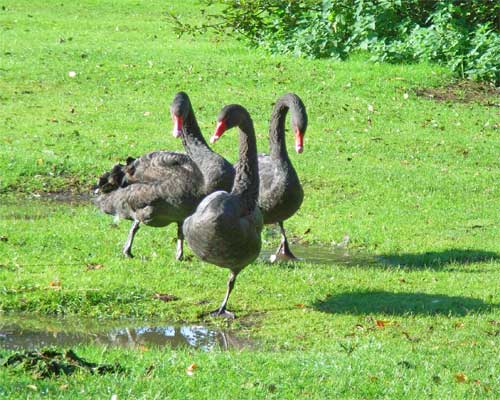 |
Black swans are indigenous to Australia and
Tasmania and several have made their home at St Peterís Pool since the summer of 1999. They
are handsome birds with dark, curly plumage, bright red bills and white wing
feathers that show only in flight. One appears on the armorial
standard of Western Australia where the Dutch discovered it in 1697.
They took it to Batavia and thence to Europe
where the existence of a black swan was regarded with amazement. Like the mute
swan, it has been successfully domesticated and raised in captivity and the
first pair was a gift from the Wildfowl Trust when a shelter was made on the
side of the pool where they later produced a number of cygnets each spring.
The black swans were soon such a familiar sight
that they have become an icon for Bourne, having been featured on the front page
of the town guide for 2004-05 and frequently on the Bourne web site which is
read around the world. Unfortunately, the original pair are now dead, one killed
by vandals early in 2007 and another by a fox, but a number of their cygnets
remained in residence.
Several of these matured and survived the years
until the summer of 2011 when St Peter's Pool dried up completely because of
prolonged drought conditions and all wildlife suffered as a result.
The wings of the swans are pinioned by law to prevent them from breeding in the
wild and so they are vulnerable to attack when there is no water in the pool. As
a result, all but one of those remaining disappeared during the drought and are
believed to have been killed by marauding dogs. But in May 2012, a pair of black
swans were introduced to the pool after being bought with money donated by the
Bourne Business Chamber.
By then, the dry spell had eased and the water level was back to normal after a
prolonged period of heavy rain. The swans came from UK Waterfowl, a breeding
farm based at Hanworth in Norfolk, and were transported to Bourne by members of the chamber.
Tim Armstrong, the secretary, said that staff at the centre showed them how to
handle the birds and although they were not particularly compliant, they did
manage to complete the operation without a hitch. "The male did not want to be
picked up when I arrived back in Bourne so I held it with some trepidation when
we unloaded. But everything turned out well."
The birds were left in a holding pen and then released on to the pool after
three days once they had become familiar with their new surroundings. "The swans
have been greatly missed since the attack and everyone is pleased to have these
back", said Mr Armstrong.
The swans will be cared for by Bourne United Charities which administers the
Wellhead Gardens and it is hoped that the pair will breed during the autumn. The
introduction of the new birds is seen as an excellent development because the
black swans have become a favourite with visitors, particularly children, who
take great delight in bringing them daily treats of bread and other tasty
morsels and as a result, they become so tame that they swim over to meet anyone
who arrives on the bank with a likely looking bag, usually with their family
close behind.
|
PHOTO ALBUM |
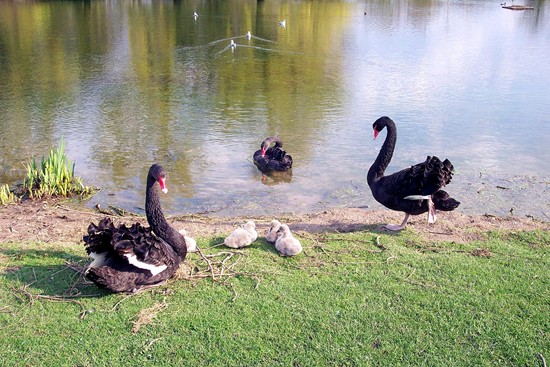 |
|
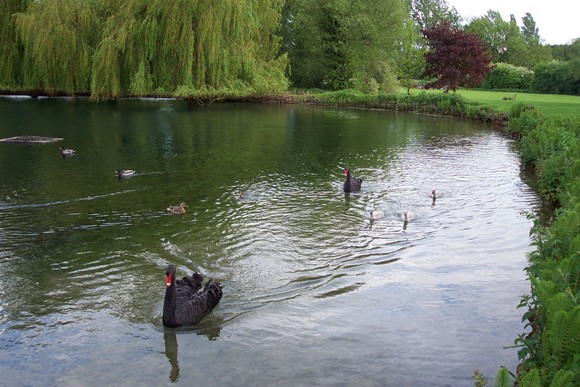 |
|
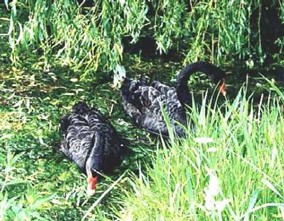 |
 |
|
The original black swans (top with three cygnets and
above left) and two of
their many cygnets, now fully grown, with friends on the edge of the pool
(right). |
|
 |
|
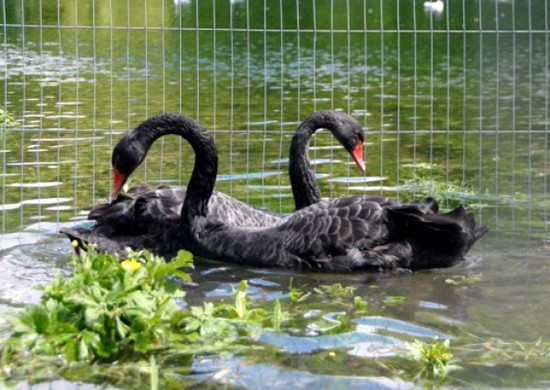 |
|
Two of the three resident black swans were killed by
marauding dogs in the spring of 2012 and a pair from a breeding farm in
Norfolk were donated by the Bourne
Business Chamber in May. They soon settled in with the one remaining bird
and within weeks had become friendly with visitors. |
|
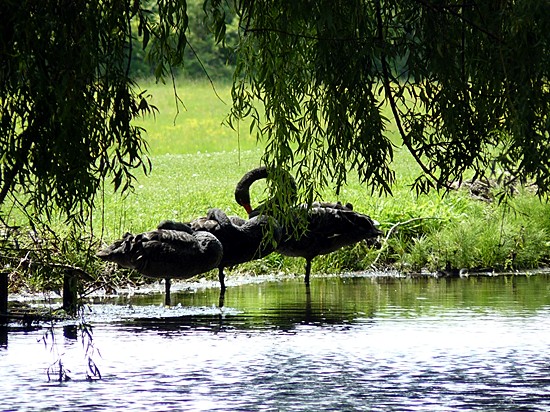 |
|
 |
|
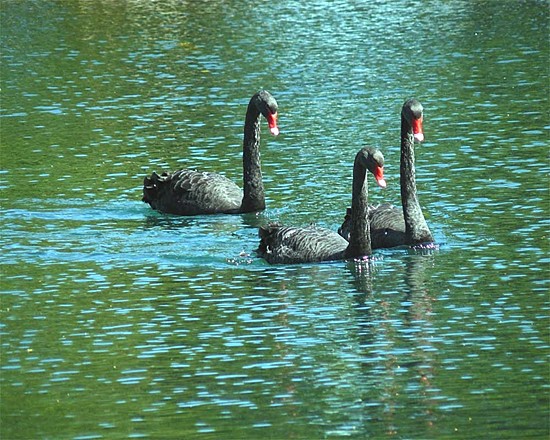 |
|
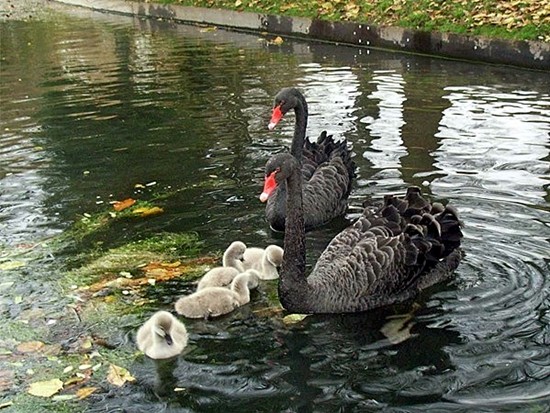 |
|
In November 2012, the new pair of swans produced six cygnets, four of
which survived, and the family soon became a popular attraction on St
Peter's Pool and along the Bourne Eau towards Baldock's Mill where they
were repeatedly photographed. Unfortunately, one of the cygnets fell prey
to a marauding fox, leaving only three but the family were still a big
attraction around the Wellhead Gardens. |
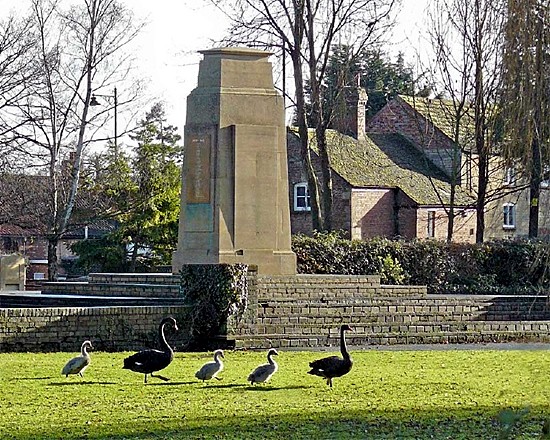 |
 |
|
Early in 2014, the black swans built a nest in a quiet backwater of the
river close to the Wellhead Gardens, a less secure nest site than the
floating platform in the middle of St Peter's Pool because it does not
give the same protection from predators and at this time there were
reports that a mink had been seen in the locality. There was also bad news
about the three young black swans that arrived last year and had grown to
maturity, one being killed by traffic on South Road and the other two had
simply disappeared although they may have flown off as their wings had not
yet been pinioned. |
|
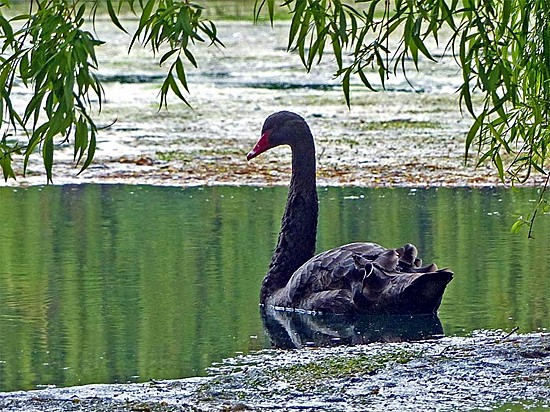 |
|
This atmospheric photograph was taken in May 2014 just as St Peter's
Pool had begun to dry up during a hot spell, leaving just a small area of
water for the waterfowl that live here and a stretch of mud beyond. |
|
RESTRICTING THEIR MOVEMENT
Strict restrictions are required in the keeping of
black swans and in August 2005, a statement was issued by Ian Peters,
wildlife advisor to the Royal Society for the Protection of Birds based at
Sandy in Bedfordshire, which said: "Under new government regulations,
anyone keeping non-native species will have to ensure that the birds do
not escape. However, there are already some feral birds around the country
although breeding is rarely successful. Black swans are rarely more
dominant than native mute swans and the latter would not allow black swans
to breed nearby."
This would indicate that legally, our black swans and their cygnets should
be pinioned to prevent them from flying away and although bird lovers may not approve, it does appear to be
a wise precaution. |
See
also
The future of our black swans
Goodbye to our black swans
Return to
St Peter's Pool

Go to:
Main Index Villages
Index
|











